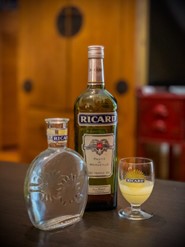The aperitif, or “apéro” as it is known in France, is much more than a simple moment of relaxation. It is a tradition deeply rooted in French culture, marking the beginning of an evening or meal with family or friends. The aperitif is a true ritual of conviviality, bringing together friends and family around a selection of tasty drinks and dishes, offering an insight into the country’s culinary wealth.
The Origins of the Aperitif
The word apéritif derives from the Latin word “aperire”, which means “to open”. This term refers to the act of opening an appetite before a meal. Historically, aperitifs were drinks served to stimulate digestion, often made of herbs or spices. Over time, this practice has evolved into a privileged moment of sharing and relaxation.
The Drinks of the Aperitif
The variety of drinks served at an aperitif is vast and reflects the diversity of tastes in France. Here are some of the most popular:
- Pastis: Originating from the south of France, especially in the region of Marseille, pastis is an anise drink usually served with fresh water. Its distinctive taste makes it a must-have for aperitifs, especially in summer.

- Kir: A blend of dry white wine and blackcurrant cream, kir is a light and sweet aperitif drink. A popular variant is the royal kir, where white wine is replaced by champagne.
- Wine: In France, wine is an institution. An aperitif can also be the occasion to taste a glass of red, white or rosé wine, depending on the region and the preferences of the guests.
- Cocktails: Cocktails also have their place during the aperitif. Spritz, for example, is becoming increasingly popular, especially in the summer, with its blend of Aperitif, prosecco and carbonated water.

- Beers: Although wine often dominates aperitifs, beer is also very popular, especially craft and local beers, which are booming in France.
The Side Dishes of the Aperitif
The aperitif would not be complete without a selection of tasty dishes to accompany drinks. The accompaniments vary widely depending on the region, the season and individual preferences, but some classics can be found everywhere in France:
- Olives: Whether green or black, plain or marinated, olives are a classic aperitif.
- Charcuterie: The sausage, in the form of sausages, hams, pâtés or rillettes, is an essential component of the aperitif. It goes perfectly with a glass of wine or beer.
- Cheeses: The assortment of cheeses is often part of the aperitif, with a preference for local and seasonal cheeses. A good camembert, a roquefort or fresh goat cheese are popular choices.
- Tapenades and “Tartinades”: Tapenades, made with olives, and tarts such as eggplant caviar or hummus are often served with toast or grits.
- Dried Fruits and Nuts: Almonds, cashews, pistachios and other dried fruits bring a crunchy and salty touch to the aperitif.
- Petit Fours and “Canapés”: In salty version, these delicate bites are ideal to vary the pleasures and surprise the guests.

The art of the aperitif
Beyond the drinks and food, the aperitif is a moment of exchange and sharing. It’s a break from everyday life, where you take time to talk, laugh and enjoy good food. In France, it is often extended, sometimes overflowing on the dinner itself, and then becomes a “dinner aperitif” where the whole meal is composed of small portions to snack.
In conclusion, the aperitif is a must-have French tradition that reflects the importance of conviviality and pleasure shared around a good table. Whether it’s an improvised moment with friends or a well-established ritual, the aperitif remains a symbol of the French art de vivre.

Some references
- “L’Apéritif à la Française” by Sylvie Girard-Lagorce. Marabout, 2006
- “Le Grand Livre de l’Apéritif” by Jean-François Mallet. Hachette Pratique, 2017
- “Aperitifs: Stylish Drinks and Snacks for Sophisticated Entertaining” by Andy Harris. Hardie Grant, 2020